Abstract
Objectives
New signal processing technologies have recently become available for Baha® sound processors. These technologies have led to an increase in power and to the implementation of directional microphones. For any new technology, it is important to evaluate the degree of benefit under different listening situations.
Methods
Twenty wearers of the Baha osseointegrated hearing system participated in the investigation. The control sound processor was the Baha Intenso and the test sound processor was the Cochlear™ Baha® BP110power. Performance was evaluated in terms of free-field audibility with narrow band noise stimuli. Speech recognition of monosyllabic phonetically balanced (PB) words in quiet was performed at three intensity settings (50, 65, and 80 dB sound pressure level [SPL]) with materials presented at 0 degrees azimuth. Speech recognition of sentences in noise using the Hearing in Noise Test (HINT) in an adaptive framework was performed with speech from 0 degrees and noise held constant at 65 dB SPL from 180 degrees. Testing was performed in both the omni and directional microphone settings. Loudness growth was assessed in randomly presented 10 dB steps between 30 and 90 dB SPL to narrow band noise stimuli at 500 Hz and 3,000 Hz.
Results
The test sound processor had significantly improved high frequency audibility (3,000-8,000 Hz). Speech recognition of PB words in quiet at three different intensity levels (50, 65, and 80 dB SPL) indicated a significant difference in terms of level (P<0.0001) but not for sound processor type (P>0.05). Speech recognition of sentences in noise demonstrated a 2.5 dB signal-to-noise ratio (SNR) improvement in performance for the test sound processor. The directional microphone provided an additional 2.3 dB SNR improvement in speech recognition (P<0.0001). Loudness growth functions demonstrated similar performance, indicating that both sound processors had sufficient headroom and amplification for the required hearing loss.
Conclusion
The test sound processor demonstrated significant improvements in the most challenging listening situation (speech recognition in noise). The implementation of a directional microphone demonstrated a further potential improvement in hearing performance. Both the control and test sound processors demonstrated good performance in terms of audibility, word recognition in quiet and loudness growth.
The requirement of patients with a mixed hearing loss for a more powerful bone conduction sound processor have been well documented (1, 2). A report by Bosman et al. (1) identified benefits of the Intenso sound processor for patients with mixed hearing loss. The Intenso was found to support an increased fitting range, while providing a sufficient dynamic range to ensure adequate audibility across numerous input levels. For patients with mixed hearing loss, a number of authors have compared the performance of the Intenso sound processor with that of hearing aids (3, 4). The studies highlighted the relationship between the degree of cochlea loss and the size of the air-bone gap. As both of these factors increase, hearing-aid performance decreases significantly to a point where the Baha® processor provides better audibility. Importantly, the size of the air-bone gap does not affect Baha's performance because the conductive component of the hearing loss is effectively bypassed. Therefore, when considering the best amplification option, a high power Baha sound processor may provide improved hearing outcomes when compared to hearing aids for patients with a large air-bone gap. De Wolf et al. (4) urged Baha system developers to improve signal processing and the fitting process so that it would be more comparable to the latest generation of hearing aids.
Consistent with that view, a number of reports have discussed the benefits in terms of hearing performance received from newer multiple-channel non-linear Baha sound processors (5-8). Additionally, with these systems, amplification targets are prescribed through the dedicated fitting software, rather than through trimpots, where the frequency response is adjusted to the patient's hearing loss configuration. These latest generation of sound processors have advanced signal processing technologies such as automatic adaptive directional microphones. Recently, a sound processor combining increased gain and output built on the same DSP technology has become available for patients with a mixed hearing loss.
Given this significant development in sound processor technology for people with a mixed hearing loss (up to 55 dB sensorineural hearing loss [SNHL]), it is important that this technology is evaluated to determine whether these mechanical and signal processing technologies increase hearing performance for this population. To determine the degree of benefit provided, an evaluation was performed to investigate potential performance improvements of the Cochlear™ Baha® BP110power sound processor (Cochlear Bone Anchored Solutions AB, Gothenburg, Sweden). For comparison, the Baha Intenso was selected as the control device because it represents the current generation of Baha sound processors for the equivalent fitting range.
In total, 20 adults with skin penetrating titanium implants for standard attachment of a Baha sound processor participated in this study (Table 1). A total of 21 subjects were originally enrolled, but one was withdrawn for not meeting the inclusion criteria of measurable open-set sentence recognition in noise with the control sound processor (Intenso). All subjects had a mixed hearing loss, defined as bone conduction thresholds (PTA, 500, 1000, 2,000, and 3,000 Hz), between 15 and 55 dBHL with at least a 10 dB air/bone gap. The average bone conduction and air conduction thresholds for the participants can be observed in Fig. 1. Each subject was selected according to internationally accepted criteria (9). All participants were experienced Baha sound processor users with at least 12 months prior use. The study was conducted following Good Clinical Practice with approval from the Regional Ethical Review Board in Gothenburg (Approval, 063-10).
Two sound processors were compared. The Baha Intenso was the control device and the Cochlear Baha BP110power was the test sound processor. It should be noted that the current study was performed with manufacturing prototypes PS1 and PS2, as the study took place before the BP110power was CE marked. Technical verification confirmed that the prototype sound processors were equivalent to the commercially available BP110power (10-12). The PS1 and PS2 prototypes were equivalent in terms of gain, output, fitting prescription, channels, and microphones. A sub-analysis comparing the comparative performance between subjects 1-10 and 11-20 demonstrated no significant differences across the test measures (P>0.05). Fig. 2 compares and full-on-gain of the Intenso and BP110power. The BP110power was designed to have a higher possible full-on-gain than the Intenso, which should be considered in any evaluation of performance. The gain and maximum output was not matched between the sound processors as the purpose of the study was to investigate what clinical differences in hearing performance might be expected for each sound processor.
The control sound processor was fitted as it would be fitted in a clinical situation. The procedures outlined in the Baha fitting guide for professionals (13) were followed. The patients adjusted the sound processor volume control setting in program 1 to match their most comfortable listening level across varied listening situations. Once the preferred level was set, this setting was used for all test measurements. All settings were confirmed to be free from acoustic feedback. Table 1 details the volume control settings used by the participants. The test sound processor was fitted using the Baha Fitting Software ver. 2.0. The Client, Indication and Connection type were configured using the BC Select step. This enables the hearing care professional to quickly set up the sound processor and incorporates the latest research data on corrections for transcranial attenuation, cross hearing, and transmission loss through the skin (7, 14). The final gain settings were based on the measurement of actual thresholds through the BC Direct function of the fitting software (15). The patients were not allowed to adjust the volume control setting during the test procedures.
All measurements were conducted in a sound-insulated room meeting ANSI standards for maximum permissible noise levels (ANSI S3.1-1999). Audiometric evaluation consisting of air and bone conduction testing was performed in accordance with ANSI S3.21 in a sound-insulated test room using a Madsen Conera Audiometer. All procedures were randomized between sound processors to control for learning and/or procedural effects. For comparison purposes, bone conduction thresholds were obtained at 500, 1,000, 2,000, 3,000, and 4,000 Hz with narrow-band noise applied via air conduction to the contra-lateral ear when necessary. Measurement of free-field audibility was collected via loudspeakers placed approximately one meter from the participant. Due to the sound processor's active feedback cancellation circuit, measurement of free-field audibility was collected using narrow band noise at 250, 500, 750, 1,000, 1,500, 2,000, 3,000, 4,000, 6,000, and 8,000 Hz.
To evaluate speech recognition in quiet surroundings, monosyllabic phonetically balanced (PB) words were used (16-18). Briefly, the test includes 12 monosyllabic phonemically balanced word lists. Each list includes 50 words within carrier phrases. The test was performed at 50, 65, and 80 dB sound pressure level (SPL) and scores were recorded as the number of correct words per list.
Speech recognition in noisy surroundings was conducted using the Swedish version of the Hearing in Noise Test (HINT) (19). Speech was presented from the front loud-speaker (0 degrees) with noise from the rear loud-speaker (180 degrees). The noise level was kept constant at 65 dB SPL and the level of the speech was adapted in 2 dB steps to provide a 50% level of understanding. For the comparisons, the sound processors' signal processing was fixed in the omni-directional mode. To compare speech-understanding performance in the omni versus directional microphone mode, the sound processor was fixed in each mode prior to testing. In all measures of speech recognition in noise, the sound processor's noise management system was disabled to ensure equivalence.
Measurement of loudness growth was conducted using narrow band noise (1/3 octave) presented with a centre frequency at 500 Hz or 3,000 Hz. The presentation level was randomly varied in 10 dB steps between 30 dB SPL and 90 dB SPL. Participants were asked to respond using a 7-point visual analogue scale ranging between very soft and very loud (1, 20).
Free-field audibility demonstrated that the test sound processor provided significantly (P<0.05 to P<0.0001) improved audibility from 3,000-8,000 Hz (Fig. 3). This is most likely related to two factors. First, the Cochlear Baha Prescription (CBP) specifically increases the amplification in the high frequencies to match the sloping hearing loss which is common in people with a mixed hearing loss. Since the control sound processor was fitted without fitting software, it can only increase the overall gain and not specifically match the hearing loss. Second, the test sound processor was designed to reduce the occurrence of internal feedback, making more gain available before feedback occurs.
Speech recognition performance in quiet surroundings (Fig. 4) showed a small (4-5%) but not significant (F[1,19]=1.83, P>0.05) improvement in speech recognition at 50 dB SPL and 65 dB SPL for the test sound processor. It is likely that for the presentation at 80 dB SPL, there was a ceiling effect since performance was above 97% for both conditions. There was, as expected, a significant improvement for each increase in presentation level (F[2,19]=286.93, P<0.0001). Importantly, this result demonstrates the benefit of the Baha solution as an intervention for people with mixed hearing loss in that it can provide open-set performance of more than 80% speech recognition at normal conversational levels without visual, grammatical or contextual cues.
The test sound processor recorded on average a 2.5 dB improvement (and microphone mode fixed to omni-directional) in terms of signal-to-noise ratio (SNR) improvement (Fig. 5). To determine statistical significance, an ANOVA was performed (F[1,19]=26.25, P<0.0001) and indicated that performance was significantly better with the test sound processor than with the control sound processor. Importantly, each subject in the study had better speech recognition scores with the test than control sound processor. Performance comparison of the omni and directional microphone modes for the test sound processor indicated a significant benefit (F[1,19]=60.49, P<0.0001) of 2.3 dB (Fig. 5). Combined, in the most difficult listening situations, this provides an average improvement of 4.8 dB SNR over the control sound processor.
Measurements of loudness growth at 500 Hz and 3,000 Hz are presented in Figs. 6, 7. Both Baha sound processors performed similarly and displayed a good dynamic range between very soft and very loud. That the average value at both 500 Hz and 3,000 Hz was below 7/7 ("very loud") may indicate that for most participants the Maximum Power Output (MPO) of the Baha sound processor is often below the patient's uncomfortable loudness level.
The present study clearly demonstrates the improved listening performance that the test sound processor (BP110power) provides for people with mixed hearing loss in challenging situations. The study demonstrates that the latest signal processing provides increased access to high frequency sounds. Importantly, a large and clinically significant improvement in speech recognition in noise was also observed. The addition of an automatic directional microphone in the power Baha segment provides a further improvement in speech recognition. Since the P/I function in the Swedish version of the HINT test is 17.9% per dB (19), the average total improvement is highly clinically significant. It is clinically important that each subject scored better with the BP110power than with the Intenso.
In their review of the Intenso, Bosman et al. (1) proposed that the next generation of power sound processors should have improved feedback performance, directional microphones and flexible fitting parameters. To address feedback issues, the BP110power has a new mechanical design where the transducer is physically isolated from the microphones to reduce internal sound transmission. This innovation has resulted in the potential for a significant increase in the available high frequency gain before feedback. Additionally, the newly patented transducer design, utilizing high-density transducer materials with Dynamic Output Stabilization, enables more powerful output and flatter frequency response to further enhance sound quality.
The addition of fitting software for patients with mixed hearing loss, where it can be hypothesized that there is more slope to the cochlear hearing loss, is invaluable. The gain and MPO were adjusted across the test sound processor's 12 channels to match the patient's hearing loss profile. It is interesting that a number of the patients with the control sound processor, despite, having on average, a large hearing loss, did not use the full volume control setting. It may be hypothesized that this is due to the sloping nature of the hearing loss and the participants setting the preferred volume control setting based on the perceived loudness in their area of best hearing acuity. Therefore, the ability to match the amplification to the hearing loss is invaluable. The audiometric results indicated that this enabled increased high-frequency amplification, leading to potentially enhanced communication performance.
In summary, the BP110power sound processor provides significant advantages in terms of supra-threshold audibility and speech recognition in noise when compared with previous gold standard sound processor such as the Baha Intenso. Loudness growth data indicate the effectiveness of prescribing amplification for this population. Furthermore, the directional microphone, available for the first time in a power processor, provides an additional increase in speech intelligibility in noisy surroundings and a reduction in listening effort.
References
1. Bosman AJ, Snik FM, Mylanus EA, Cremers WR. Fitting range of the Baha Intenso. Int J Audiol. 2009; 48(6):346–352. PMID: 19925342.

2. Wazen JJ, Van Ess MJ, Alameda J, Ortega C, Modisett M, Pinsky K. The Baha system in patients with single-sided deafness and contralateral hearing loss. Otolaryngol Head Neck Surg. 2010; 4. 142(4):554–559. PMID: 20304277.

3. Flynn MC, Sadeghi A, Halvarsson G. Baha solutions for patients with severe mixed hearing loss. Cochlear Implants Int. 2009; 10(Suppl 1):43–47. PMID: 19195004.

4. De Wolf MJ, Hendrix S, Cremers CW, Snik AF. Better performance with bone-anchored hearing aid than acoustic devices in patients with severe air-bone gap. Laryngoscope. 2011; 3. 121(3):613–616. PMID: 21344443.

5. Davison T, Leese D, Marley S, Johnson IJ. Clinical impressions of a new Bone Anchored Hearing Aid processor. In : 2nd International Symposium on Bone Conduction Hearing - Craniofacial Osseointegration; 2009 Jun 11-13; Goteborg, Sweden.
6. Flynn MC, Sadeghi A, Halvarsson G. Benefits of directional microphones and noise reduction circuits for improving Baha hearing performance. Cochlear Implants Int. 2011; 5. 12(Suppl 1):S139–S141. PMID: 21756499.
7. Flynn MC. Challenges and recent developments in sound processing for Baha. Adv Otorhinolaryngol. 2011; 71:112–123. PMID: 21389711.
8. Pfiffner F, Caversaccio MD, Kompis M. Comparisons of sound processors based on osseointegrated implants in patients with conductive or mixed hearing loss. Otol Neurotol. 2011; 7. 32(5):728–735. PMID: 21646934.

9. Snik AF, Mylanus EA, Proops DW, Wolfaardt JF, Hodgetts WE, Somers T, et al. Consensus statements on the Baha system: where do we stand at present? Ann Otol Rhinol Laryngol Suppl. 2005; 12. 195:2–12. PMID: 16619473.

10. Cochlear Bone Anchored Solutions. Verification protocol, G3 power (9228). 2011. Molnlycke, Sweden: Cochlear Bone Anchored Solutions.
11. Cochlear Bone Anchored Solutions. G3 power verification record. 2011. Molnlycke, Sweden: Cochlear Bone Anchored Solutions.
12. Cochlear Bone Anchored Solutions. G3 power PS4 verification test report. 2011. Molnlycke, Sweden: Cochlear Bone Anchored Solutions.
13. Cochlear Bone Anchored Solutions. Baha fitting guide for professionals (E81231). 2008. Molnlykke, Sweden: Cochlear Bone Anchored Solutions.
14. Flynn MC, Sammeth CA, Sadeghi A, Cire G, Halvarsson G. Baha for single-sided sensorineural deafness: review and recent technological innovations. Semin Hear. 2010; 11. 31(4):326–349.

15. Andrew R, Green KM. Unilateral conductive and sensorineural hearing loss with BC direct. Audiol Neurootol. 2011; 16(Suppl 1):23–25. PMID: 20516679.
16. Liden G. Speech audiometry; an experimental and clinical study with Swedish language material. Acta Otolaryngol Suppl. 1954; 114:1–145. PMID: 13147805.
17. Liden G, Fant G. Swedish word material for speech audiometry and articulation tests. Acta Otolaryngol Suppl. 1954; 116:189–204. PMID: 13188683.
18. Arlinger S. Nu finns testlistor pa CD. AudioNytt. 1988; 15(3):4–5.
19. Hallgren M, Larsby B, Arlinger S. A Swedish version of the Hearing In Noise Test (HINT) for measurement of speech recognition. Int J Audiol. 2006; 4. 45(4):227–237. PMID: 16684704.
20. Cox RM, Alexander GC, Taylor IM, Gray GA. The contour test of loudness perception. Ear Hear. 1997; 10. 18(5):388–400. PMID: 9360862.

Fig. 1
Mean bone conduction and air conduction thresholds for the study participants demonstrating the mixed hearing loss. The shaded area highlights one standard deviation of the mean.
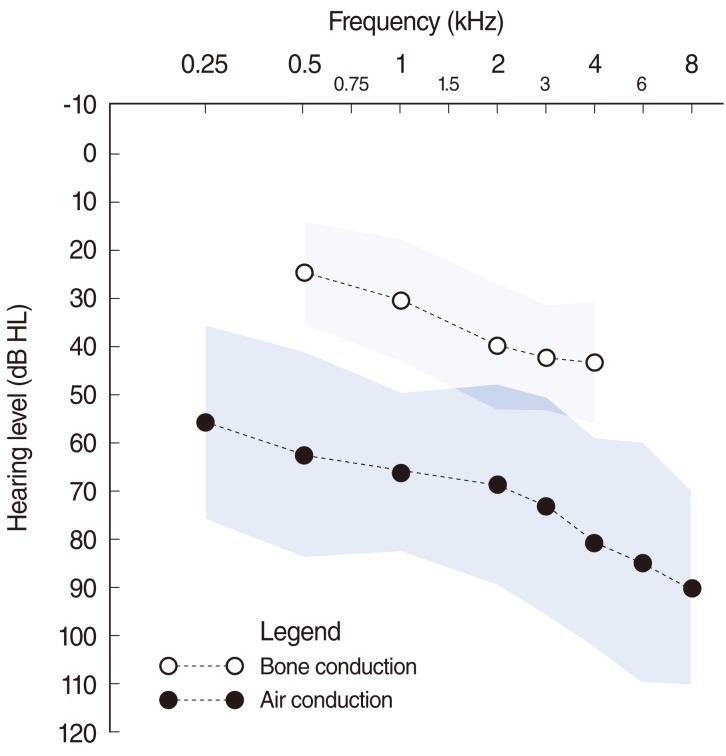
Fig. 2
Comparison of the maximum gain between the control and test sound processors. Due to improved design and feedback, the available gain in the test sound processor is higher across the mid frequencies by approximately 5 dB.
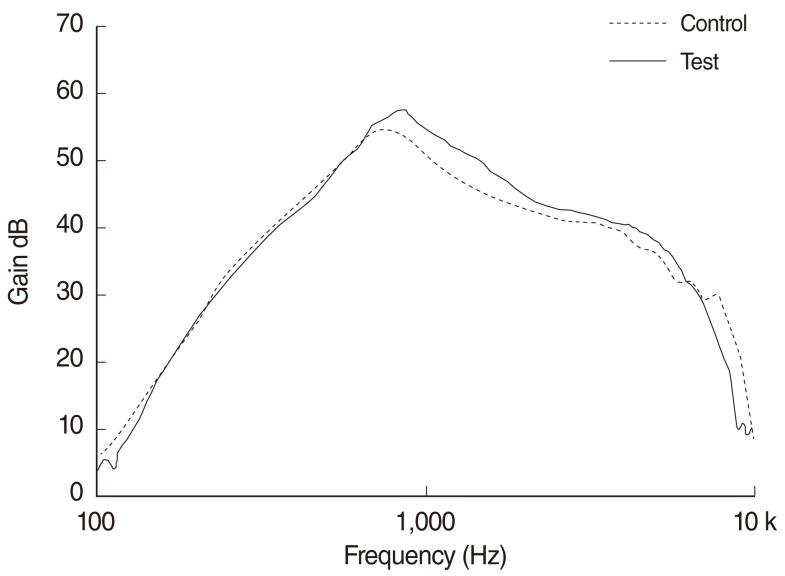
Fig. 3
Free-field aided thresholds (dB sound pressure level, SPL) as measured for the control and test sound processor. The differences from 3,000 to 8,000 were statistically significant (P<0.05). The air conduction values are also displayed to provide an indication of the overall degree of functional gain.
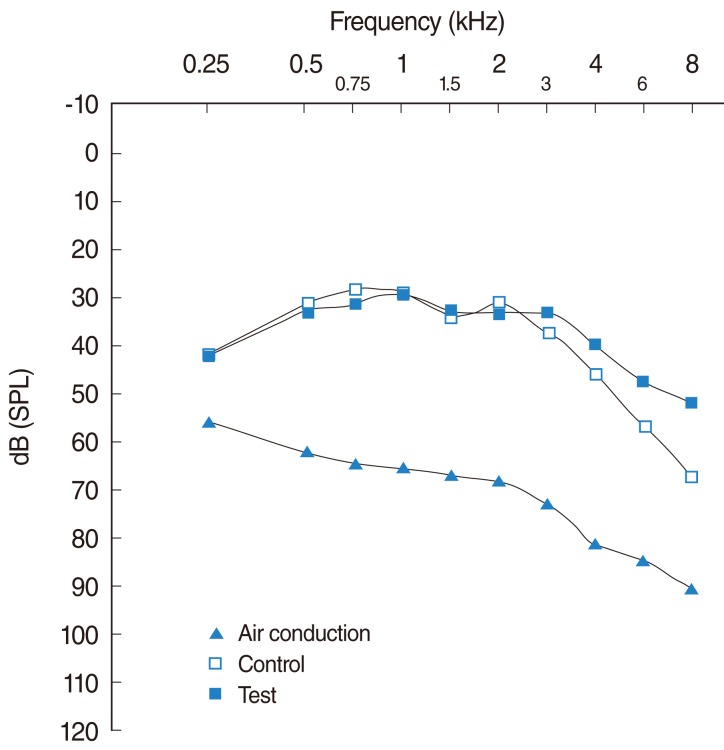
Fig. 4
Comparison of percentage correct for phonetically balanced words presented in quiet at three presentation levels for the control and test sound processors. Error bars equal one standard error of the mean. There was a significant difference (P<0.0001) in terms of level but not for sound processor type (P>0.05). SPL, sound pressure level.
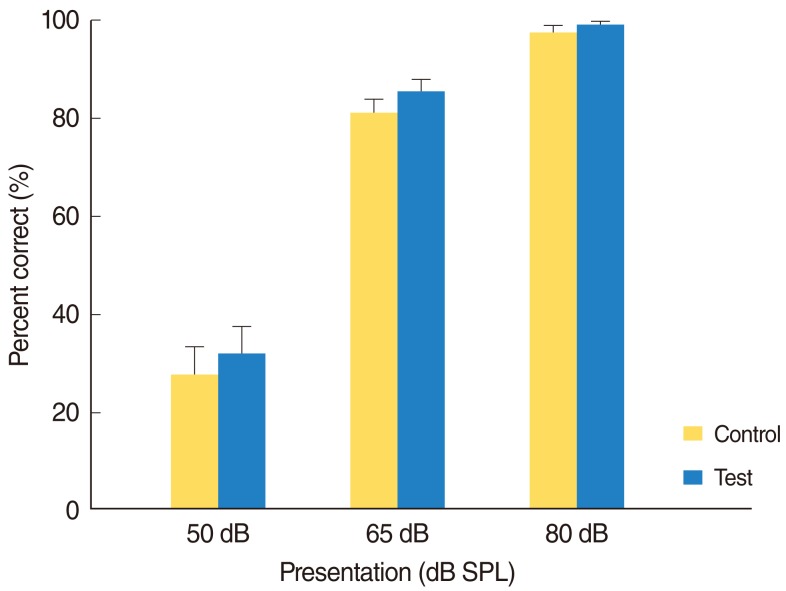
Fig. 5
Comparison of speech recognition in noise performance of the control and test sound processors demonstrating a 2.5 dB mean improvement in signal-to-noise ratio (SRN; P<0.0001). Comparison of the omni-directional and directional microphone in the test sound processor showed a further 2.3 dB advantage in speech recognition in noise (P<0.0001). Error bars indicate one standard error. Better performance is indicated by 50% performance in a poorer SNR.
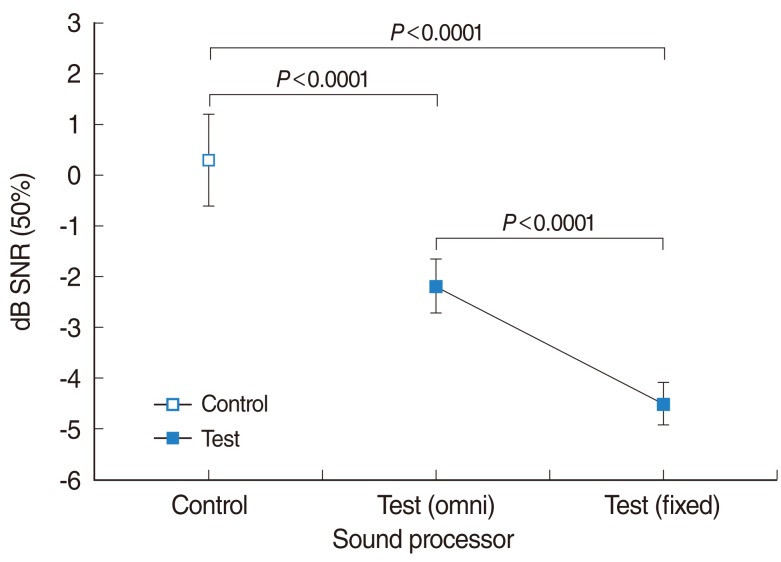




 PDF
PDF Citation
Citation Print
Print


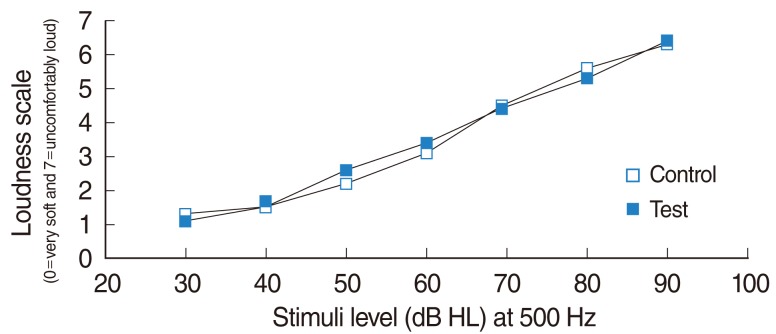
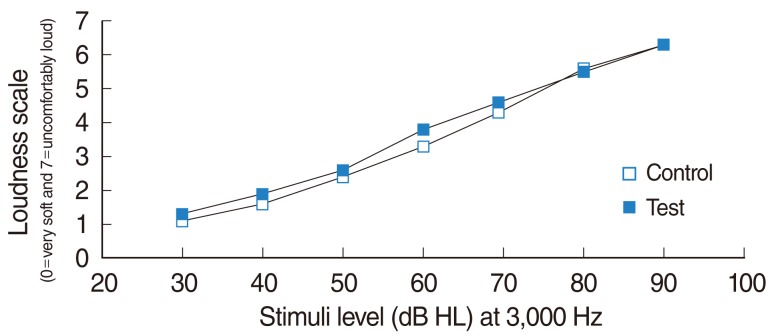
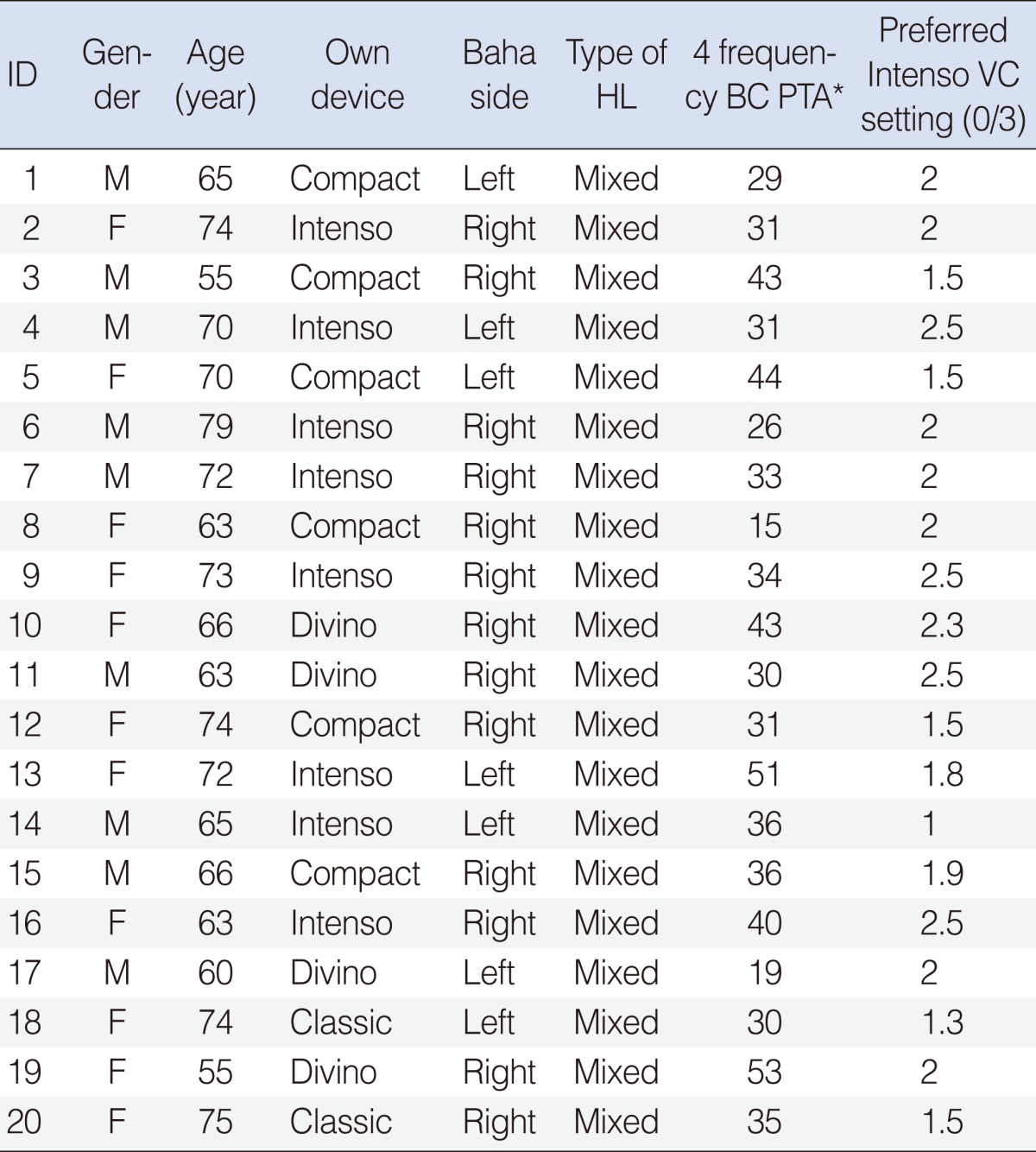
 XML Download
XML Download